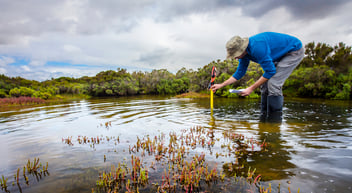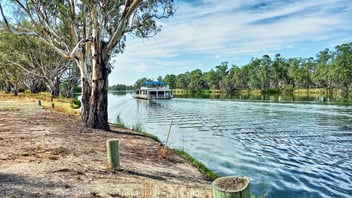World Environment Day: catchment management meets conservation

With land restoration and drought resilience closely linked, many water authorities and catchment managers around Australia are in a unique position to help conserve and protect ecosystems while also creating more resilience and water security.
This year’s World Environment Day (5 June) is focused on land restoration, desertification and drought resilience, leaning into a key pillar of the UN Decade on Ecosystem Restoration (2021-2030) – a call for the protection and revival of ecosystems all around the world.
To mark the day, Water Source caught up with Melbourne Water – in 2022, the organisation became the official catchment management authority (CMA) to manage all catchment and waterways functions for the Port Phillip and Western Port region.
Located on the traditional lands of the Wadawurrung, the Wurundjeri Woi-wurrung and the Bunurong Peoples, the Port Phillip and Western Port region is Victoria’s most diverse and complex natural resource management region in terms of geography, land use and population.
Covering almost 13,000 square kilometres, the region extends from the You Yangs Ranges in the west, across the Macedon Ranges and the Kinglake Plateau in the north, through the Yarra Valley to the foothills of the Baw Baw plateau in the east and south to the Bass Coast.
The region also includes Victoria’s two largest islands, French and Phillip Islands.
Melbourne Water Acting Senior Manager Waterways Biodiversity & Environment Jesse Barrett said land restoration and biodiversity protection are an important focus for Melbourne Water not only because of its role as CMA, but also because of the role these efforts play in water security.
“Biodiversity protection is essential because urbanisation and climate change are altering habitat and impacting biodiversity values in our region,” he said.
“Land restoration can reverse degradation, desertification and impacts of drought.
“Land restoration makes it possible to repair the land’s role in storing carbon, reducing the risk of droughts and floods and increasing soil productivity, protecting biodiversity and waterway health.
“Melbourne Water, as a CMA and waterway manager, is committed to restoring, enhancing and protecting the environment to benefit the community and native wildlife, sustain and enrich life, economies, health and social wellbeing today, tomorrow and for generations to come.”
Unique biodiversity
Including five major catchment systems – the Werribee, Maribyrnong, Yarra, Dandenong and Western Port – the region’s land and waterways form a complex network of interconnected rivers, wetlands and estuaries, which flow to Port Phillip Bay and Western Port.
Representing a vibrant hub of natural assets and unique biodiversity, Melbourne Water’s catchment management region is home to some of Victoria’s most iconic species, including the Helmeted Honeyeater, the Leadbeater’s Possum and the Weedy Sea-dragon.
The region also contains three internationally recognised Ramsar wetlands, including Western Port, Edithvale-Seaford wetlands and approximately 30% of the Port Phillip Bay and Bellarine Peninsula site.
Barrett said the region showcases a remarkable array of species and habitats of national and international significance that require considered protection and management.
“The Port Phillip and Western Port region is home to roughly 627 species of native fish, amphibians, reptiles, birds and mammals, and many smaller animal species like insects,” he said.
“Our waterways and catchments are home to koalas, kangaroos and platypus, as well as local species like the endangered Helmeted Honeyeater and the Leadbeaters Possum.
“Many of our wetlands contain significant and rare vegetation communities, attracting thousands of migratory birds each year from as far as Alaska, Siberia, China and Japan.”
Strategy in action
Melbourne Water’s approach to catchment management and conservation is outlined in the Port Phillip and Western Port Regional Catchment Strategy, Barrett said.
“The Port Phillip and Western Port Regional Catchment Strategy broadly describes how land, water and biodiversity is managed and identifies targets for future health and resilience,” he said.
“The strategy incorporates 15 themes focused on the building blocks of a healthy and resilient environment, such as climate change, native animals, native vegetation, soil health and land use.”
Honing in on water, biodiversity, land, coastal and marine environments and community sectors, the strategy includes policy and planning in place, current conditions and trends, major threats, a vision and targets for future conditions, and the partnerships to help achieve those targets.
Partnership is a keen focus of the strategy, leaning into the experience and knowledge of some 87 Landcare Groups, 13 Landcare networks and over 500 Friends groups, as well as committees and other environmental groups working across the region.
Barrett said working alongside Traditional Owners and community groups is integral to the work.
“Melbourne Water is currently involved in many land restoration programs and activities collaborating with the community, Traditional Owners and multi-agency programs like Yarra4Life, which has been working on creating potential habitat for Helmeted Honeyeaters and Leadbeaters Possums on public and private land in the Yarra Valley,” he said.
Yarra4Life is long-term goal is to have habitat links from the Yellingbo Nature Conservation Reserve north to the Yarra Ranges National Park, south-east to Kurth Kiln Regional Park, and west to the Dandenong Ranges National Park.
“We are also planning stormwater harvesting projects and have constructed seven new fishways since 2018,” Barrett said.
“The Healthy Waterways Strategy sets targets for waterway management and land restoration. So far, we have established 2000 hectares of new vegetation and managed another 10,800 hectares of existing vegetation.”
Another example is an innovative new project establishing a smart water network to mitigate climate extremes within east Melbourne’s Monbulk Creek to create a more stable habitat for vulnerable platypus populations.
Projections indicate that platypus within the Monbulk Creek system are likely to be lost if flows in the urban waterway are not managed for habitat protection, and that complementary works, like streamside revegetation and litter management, will also be needed.
Led by Melbourne Water and the University of Melbourne in partnership with Yarra Ranges Council, South East Water, DEECA and the Australian Research Council, the project came out of Melbourne Water’s Healthy Waterways Strategy 2018 and was co-designed with key stakeholders.


